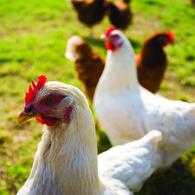[[ JUMP TO THE SECTION ADVISING WHERE TO CLEAN AND WHICH PRODUCTS TO USE ]]
An avian influenza (bird flu) outbreak is rapidly spreading across the globe. Between October 2021 and the first week in January 2022, nearly 40 countries had reported incidents of large numbers of wild birds dying, one of which noted 5000 dead cranes found in the Hula Lake Reserve in northern Israel. In Europe, the outbreak has been classified as the worst ever in the region by The Friedrich Loeffler Institute (FLI), Germany’s Federal Research Institute for Animal Health.
What is Avian Influenza / Bird Flu?
Avian influenza, also known as bird flu, is an acute infection caused by Type A Influenza Virus which is almost exclusively found in birds. The virus is highly contagious and fatal, having respiratory, peptic and nervous symptoms. The death rate in infected flocks can be up to 100%.
The avian influenza agent is an enveloped virus of RNA character. It is sensitive to certain disinfectants, temperature (>70°C), environmental conditions, low and high pH and drying. The virus remains viable for extended periods in tissues, faeces and water, especially in cold and humid environments. However, as the outer wall of the virus is enclosed within a lipid-containing membrane, this virus can easily be inactivated and stabilized, for example, with chemical disinfectants/sanitizers or ultraviolet light.
How is Avian Influenza Transmitted?
The avian influenza virus is transmitted in nasal secretions and faeces from infected birds and can remain viable for about five weeks under poultry house conditions. For this reason, one of the most critical issues regarding infection control is manure.
The virus can remain viable for longer periods under the high humidity and low temperature of faeces. The virus can survive up to 3 months in the tissues and faeces of infected birds.
In water, the virus can survive for up to 4 days at 22°C and more than 30 days at 0°C.
Migratory birds play a primary role in transmitting and introducing avian influenza into flocks. However, feed, water, equipment and personnel contaminated with faeces or secretions from infected birds or broken eggs are also a serious cause of the spread of infection. These factors can introduce the infection to a farm and spread it within and to other farms.
Horizontal contagion (from bird to bird) is the most common mode of viral transmission within flocks. There is no indication of vertical contagion (from bird to chick via egg), but chicks are susceptible to infection after hatching, especially if biosecurity in the hatchery is poor1.
How to Reduce the Spread of Bird Flu
Biosecurity measures should be implemented across the poultry sector’s entire supply chain to limit transmission. The three principle elements of biosecurity are:
- Segregation: The creation and maintenance of barriers to limit the potential opportunities for infected animals and contaminated materials to enter an uninfected site. This step, properly applied, will prevent most infections.
- Cleaning Materials: (e.g. vehicles, equipment) that have to enter or leave a site must be thoroughly cleaned to remove visible dirt; this will remove most of the virus contamination.
- Disinfection/Sanitation: Properly applied, disinfection will inactivate any virus present on materials after they have been thoroughly cleaned.

Focus on Cleaning to Limit the Impact of Avian Influenza
The effectiveness of disinfectants is directly impacted by how clean the surface is before the disinfection step. Good cleaning (manure removal and surface washing) reduces 90-91% of the microbial load. Disinfection achieves around 6-7% and terminal fumigation around 1-2%.
Where to Clean and What Diversey Products to Use
Diversey’s Divosan Viragri Plus VT49 and Divosan Suredis VT1 have proven effective against viricidal activity per EN 14675 and EN 14476 quantitative suspension tests, respectively. We also have a wide range of detergents, sanitizers and disinfectants with specific suitability to the food and beverage industry and the types of soils and surfaces typically found (please contact us or your Diversey representative to confirm local product range and availability).
Interior & Exterior Area Cleaning
EnduroSuper VE13. Self-foaming extended contact cleaner, 4-10% use concentration.
Interior & Exterior Area Disinfection
- Viragri Plus VT49. Non-oxidizing disinfectant effective against viruses, 1-3% use concentration.
- Oxivir Plus Spray. Fabric safe disinfectant, direct use without dilution.
- Tego 2000 VT25. Amphoteric-based disinfection, 0.5-2% use concentration.
Heavily Soiled Equipment Cleaning
EnduroSafe VE7. Medium - Alkaline high retention cleaner, 4-6% use concentration.
Descaling
Acifoam VF10. Acid foaming detergent, 3-10% use concentration.
Water System Cleaning
Divosan TC 86 VS8. Chlorinated detergent, 2-4% use concentration.
Water System Disinfection
Zal Perax II VT48. Peracetic acid-based disinfection, 0.2-2% use concentration.
Feed Bin Disinfection
Tego 2000 VT25. Amphoteric-based disinfection, 0.5-2% use concentration.
Boot Dip
- Viragri Plus VT49. Non-oxidising based disinfection, 1-3% use concentration.
- Tego 2000 VT25. Amphoteric-based disinfection 1% use concentration.
- Zal Perax II VT48. Peracetic acid-based disinfection 0.5-1% use concentration.
Wheel Dips
- Tego 2000 VT25. Amphoteric-based disinfection, 1% use concentration.
- Zal Perax II VT48. Peracetic acid-based disinfection 0.5-1% use concentration.
Air Disinfection
- Tego 2000 VT25. Amphoteric-based disinfection, 1-2% use concentration.
- Viragri Plus VT49. Non-oxidising based disinfection, Fogging 4-5% use concentration.
- Zal Perax II VT48. Peracetic acid-based disinfection, 4% use concentration.
Box/Tray Washing (Cleaning & Disinfection)
Divosan TC 86 VS8. Chlorinated detergent, 1-2% use concentration.
Box/Tray Cleaning
Spectak G VC1. Low foam, caustic 0.3-5% use concentration.
Box/Tray Disinfection
Divosan Hypochlorite VT3. Hypochlorite based disinfectant, 0.25-1% use concentration.
Operator Hand Hygiene
- Soft Care Sensisept H34. Extra mild handwash and disinfectant, direct use without dilution.
- Soft Care Med H5. Hand disinfectant, direct use without dilution.
- Soft Care Plus H41. Hand soap, direct use without dilution.
General Precautionary Measures Against Bird Flu
- Disinfection steps should be implemented at the entrances and exits of farms and should be strictly controlled.
- Transport and movement in and out of the farm should be limited to those who work there or require access for important reasons. The number of entrances/exits should be kept to a minimum.
- Disinfection steps should be increased in the inner and outer areas of the farm, i.e. by implementing more foot dips and hand wash stations between areas to prevent cross-contamination.
- At entrances and exits of farms, the disinfection of feed and poultry vehicles should be of high priority and performed using appropriate disinfectants.
- Pest controls should be increased with specific attention to wild birds.
- Personnel at farms and plants should wear appropriate protective clothing (such as hairnets, hats, overalls, gloves, goggles, masks, overshoes) and ensure they are changed and disinfected frequently.
- Personnel should use foot dip pools for foot disinfection when entering and exiting coops or poultry and slaughterhouse buildings.
- Disinfectant solutions should be checked and replaced frequently.

References
Additional Resources
https://www.cdc.gov/flu/avianflu/index.htm
https://www.gov.uk/guidance/avian-influenza-bird-flu
https://www.poultryworld.net/Health/health_tool/Avian-influenza-fowl-plague/
https://www.izsvenezie.com/reference-laboratories/avian-influenza-newcastle-disease/europe-update/
https://ec.europa.eu/food/animals/animal-diseases/diseases-and-control-measures/avian-influenza_en
https://www.fao.org/documents/card/en/c/a37dd6ce-26d4-5ed3-ab39-1c5165047b35/
https://www.sciencedirect.com/topics/medicine-and-dentistry/avian-influenza-h5n1









